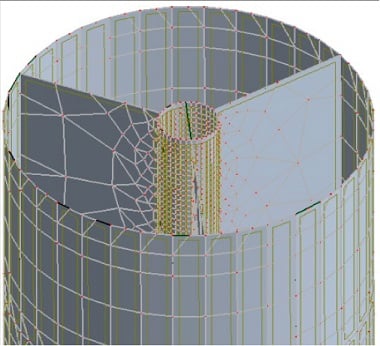Water sector blazes a trail for low carbon 3D construction printing on site

Photo caption: Structural design for a ChangeMaker 3D printed wastewater distribution chamber. (C) Constructure Ltd 2021.
The water sector could soon be the first in the UK able to print made-to-measure objects out of sustainable concrete on site.
A new partnership between United Utilities and progressive start-up Changemaker 3D Ltd has moved forward the possibilities of concrete-printing technology in a way that will ultimately benefit other sectors, innovators believe.
The methodology, a first for the UK, was developed by ChangeMaker 3D and was incubated in the North West water company’s latest Innovation Lab. It could have enormous environmental, time and cost savings and be an important factor in the sector’s race to net zero carbon by 2030.
The projected reduction in carbon emissions alone for an on-site printed wastewater distribution chamber is 25%, with a 20% reduction in cost and even bigger savings in time and labour. United Utilities own over 200 distribution chambers across the North West.
Selwyn Rose, innovation strategy manager for United Utilities said: "Until now, most UK concrete-printing has been focussed on standard items pre-fabricated in factories. More complex made-to-measure items have tended to be manufactured overseas and shipped to site.
“But with the unrivalled access to our sector expertise, resources and data as part of the Innovation Lab, alongside valuable insight from construction delivery partners and managed service partners on both sides, Changemaker3D have succeeded in building a complex digital model which could be built in situ. It’s got massive potential."
To test the concept, Changemaker3D and United Utilities engineers joined forces. ChangeMaker 3D enlisted strategic input from long-standing partners AutoMutatio, change management experts, and Constructure – leading consultants in structural design. ChangeMaker 3D had already worked to develop and prove the emerging technology over 3 years, but needed a test case here in the UK – the opportunity provided by United Utilities was a perfect fit.
The combined team needed a substantial product with enough complexity and risk to challenge traditional technologies and push forward the boundaries of on-site construction. They chose to model a real-life wastewater distribution chamber, which was actually being built at a site in Cumbria.
Over the course of 10-weeks, an accurate digital model was created for the 1.8m diameter cylindrical chamber, including interior dividing walls, which in real-life would be partially submerged 1.4m below ground.
The next step will be to manufacture a prototype off-site in a factory, which can be subjected to rigorous construction tests to make sure it meets the operational, strength and durability requirements for such a key piece of kit.
The final step, expected towards the end of November, will be a live demonstration of the concrete printing technique to which construction partners will be invited.
Natalie Wadley, director of Worcestershire-based Changemaker 3D, said the printing process usesa portable CyBe robotic arm and quick drying CyBe mortar, which piped layers of concrete in formation.
“By analysing the 3D digital model with a traditional design we were able to draw comparisons which suggest a 25 per cent reduction in carbon, a 20 per cent reduction in cost, construction time cut by a half, and the amount of labour by 55 per cent,” she said.
“Low carbon concrete-printing also removes several steps from the construction process which in turn enhances safety. It reduces the need for working at height and in confined spaces,” she said.
United Utilities’ chief innovation engineer, Lisa Mansell said: “We are really excited by this technology. The sector has big challenges on the time and cost of construction across this current AMP, but the biggest challenge for the water industry right here and now is reducing our carbon footprint. One of our biggest carbon impacts is construction projects, particular where we need to use concrete solutions.
“What we now need to do is show that it works physically, testing the finished article is structurally sound, technically feasible and passes tests on things like water permeability. This will help us get our construction partners comfortable with it.’
Changemaker 3D is one of eight finalists to emerge from United Utilities’ highly-regarded Innovation Lab - an annual event where the water giant opens up its huge wealth of data, systems and expert knowledge to incubate new ideas and help bring them to market.
It was an important step for the progressive young business – a husband and wife team co-founded by Luke and Natalie Wadley in 2017 with the benefit of over 20 years’ industry and board level experience. Their vision is to create a sustainable built environment that delivers value for society and a lighter footprint for the planet.
Added Natalie: “It’s exciting for Changemaker 3D to be able to come into a new market and work with a potential supplier like United Utilities, who will also benefit by being the first UK company out of the starting blocks. Other sectors are already sitting up and taking an interest in our strong commercial proposition. As well as being a technology for good, concrete printing is safer to build and saves time and cost. This is good for customers, the water sector and the UK construction industry as a whole,” she said. /Ends